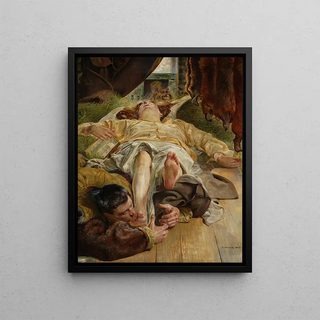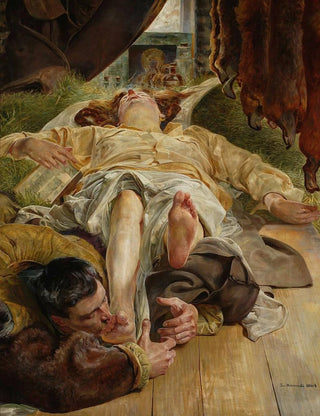Art print | Death of Ellenai - Jacek Malczewski


View from behind

Frame (optional)
Mort of Ellenai - Jacek Malczewski – Engaging introduction
The canvas "Mort of Ellenai" by Jacek Malczewski is an iconic artwork that immerses the viewer in a universe both tragic and poetic. Created at the end of the 19th century, it reflects the artistic sensitivity of a Polish painter whose work is marked by deep introspection and an exploration of themes of death and memory. This piece, rich in symbolism, evokes the pain of loss and the fleeting beauty of life. Through a meticulously crafted composition, Malczewski invites everyone to reflect on the human condition, while celebrating the beauty of profound feelings that dwell within us.
Style and uniqueness of the artwork
The style of "Mort of Ellenai" is distinguished by a harmonious fusion of symbolism and realism, characteristic of the artistic movement of the time. The colors, both vivid and dark, create an atmosphere imbued with melancholy, while the delicate forms of the characters seem to blend into a dream. The central figure, Ellenai, is depicted with a haunting grace, her face marked by a disturbing serenity in the face of the inevitable. The detailed costumes and natural elements surrounding her reinforce the idea of a world that is both tangible and ethereal. Malczewski skillfully plays with light and shadow, emphasizing the drama of the scene while offering a reflection on the fleeting beauty of existence. This artwork is not merely a simple representation; it is a true invitation to introspection.
The artist and his influence
Jacek Malczewski, born in 1854, is one of the major figures of Polish art. His artistic journey is marked by an unceasing quest for national identity and an exploration of universal themes such as love, death, and spirituality. Influenced by European artistic currents, he managed to create a unique style that combines tradition and modernity. Malczewski was able to capture the essence of his time while echoing Polish culture. His ability to translate complex emotions through painting has

Matte finish

View from behind

Frame (optional)
Mort of Ellenai - Jacek Malczewski – Engaging introduction
The canvas "Mort of Ellenai" by Jacek Malczewski is an iconic artwork that immerses the viewer in a universe both tragic and poetic. Created at the end of the 19th century, it reflects the artistic sensitivity of a Polish painter whose work is marked by deep introspection and an exploration of themes of death and memory. This piece, rich in symbolism, evokes the pain of loss and the fleeting beauty of life. Through a meticulously crafted composition, Malczewski invites everyone to reflect on the human condition, while celebrating the beauty of profound feelings that dwell within us.
Style and uniqueness of the artwork
The style of "Mort of Ellenai" is distinguished by a harmonious fusion of symbolism and realism, characteristic of the artistic movement of the time. The colors, both vivid and dark, create an atmosphere imbued with melancholy, while the delicate forms of the characters seem to blend into a dream. The central figure, Ellenai, is depicted with a haunting grace, her face marked by a disturbing serenity in the face of the inevitable. The detailed costumes and natural elements surrounding her reinforce the idea of a world that is both tangible and ethereal. Malczewski skillfully plays with light and shadow, emphasizing the drama of the scene while offering a reflection on the fleeting beauty of existence. This artwork is not merely a simple representation; it is a true invitation to introspection.
The artist and his influence
Jacek Malczewski, born in 1854, is one of the major figures of Polish art. His artistic journey is marked by an unceasing quest for national identity and an exploration of universal themes such as love, death, and spirituality. Influenced by European artistic currents, he managed to create a unique style that combines tradition and modernity. Malczewski was able to capture the essence of his time while echoing Polish culture. His ability to translate complex emotions through painting has






